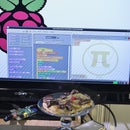Introduction: Pi Day 2014: Feynman Nine Clementine-Mincemeat Pi(e)
Happy Pi Day! With this year's pie, we decided to celebrate our favorite Nobel Prize Winner and Bongo Player, Richard Feynman.
Sparky and I still have a tradition of bedtime reading for the time being, even though he's now bigger than me (gasp!) Recently, we read "Surely You're Joking, Mr. Feynman" (because, really, why wouldn't a tween love reading the misadventures of a socially oblivious physics professor?) One of the joys of reading with your kid is watching them see a kindred spirit unfold with each page: as the professor told tales of his famous smartassery, Sparky began to react...eventually with a familiarity you'd expect from Feynman's college roommate. As the tales grew taller, each was greeted with a slightly-more-exaggerated facepalm and a bemused growl of "feynMAN!" (I must admit, every time it happened I danced an internal jig of glee.)
The Feynman Point is an example of smartassery: at the 762nd decimal place in pi, there is a series of six 9s. Once during a lecture, Feynman is supposed to have quipped that he'd like to recite all those digits, but after reading these nines, stop and say "and so on..." Much like Feynman, pi artfully follows its own rules; after the 6-digit repeat it once again shows itself to be an irrational number by moving on to the number 8. The joke is that if it had continued with nines the way Feynman implied, pi would be a rational number - but you'd have to be able to calculate it to the 769th place to know he was kidding. (A rational number is a number that can be written as a fraction. All whole numbers, terminating decimals, and any non-terminating decimal that repeats pattern of numbers are rational numbers; infinitely repeating nines also represent a rational number. Pi is one of the most famous irrational numbers, in that...so far as we know...it can only be accurately written as a decimal.)
So, how to make a pie using the idea of a sequence of 9s? I decided to look around on the internet for ways in which the number 9 related to food, and found Feeding Nine Billion, a project concerned with feeding the predicted 9 billion people estimated to live on earth in 2050. One item on their list of 10 actions ordinary people can take rang true to me: reducing food waste. Over one-third of our food in the US is wasted at some point in the food chain, so I resolved to create a pie that uses food that might otherwise go to waste. I needed look no further than my fruit bowl: we often struggle to use up citrus and apples when they've become "lumpy" but are still good to eat.
Interestingly, pies may have originated as a method of food preservation, so this actually moves us in the right direction. You see, before refrigeration or even canning, removing water was one of the few ways cooks had to prevent mold or bacterial growth. Putting a filling inside a dry, fatty, grain-based crust was the closest thing cooks in the middle ages had to a ziploc bag, with the fat in the crust providing a barrier to the moisture in the filling. Mincemeat is another method of preservation: dried fruits cooked in a boozy spiced sauce, typically also with a fat like suet to retard moisture (ours is boozy, but untraditionally lean.)
Step 1: Digestive Biscuit Crust
1 1/4 cups rolled oats
1 cup whole wheat flour
1 tsp baking powder
3/4 cup brown sugar
1 stick salted butter, frozen hard
2-4 tbsp milk
First, whiz the oatmeal into flour in your blender. Pour all the dry ingredients into a bowl and mix them thoroughly. Cut the butter into chunks and put it in a food chopper or food processor; grind it into "gravel." Pour the butter into the dry ingredients, add half of the milk and mix well. Continue to work the butter into the dough, lightly pinching it together and adding milk as needed until it holds its shape when you crush it into a ball.
Divide the dough in thirds and put two thirds into your pie pan. Using a glass, push and twist it into a bottom crust. Poke it all over with a fork.
Roll the remaining dough into a log, and then cut the log lengthwise so that the side forms the shape of the number 9. Put the log of dough into the freezer while you make the mincemeat.
Par-bake your bottom crust in a 350 degree oven for 15 minutes.
Step 2: Mincemeat Filling
2 cups of dried fruit of your choice (now's the time to empty your cupboards!) chopped to the size of raisins
1 apple, diced
2 tbsp. minced candied ginger
1/2 cup brown sugar
2 tablespoons orange liquor (I used Cuantro)
Juice and zest of 1 orange (I used a blood orange because I had one)
Zest of 1 grapefruit (or other citrus)
1 cup of water
1 tbsp. "instant" flour (like Wondra)
Mix all the ingredients except the flour and liquor. Add them to a saucepan and bring to a boil. Reduce to a simmer and cook until most of the liquid is absorbed, about 7-10 minutes. Sprinkle with the flour, stir and bring back to a full boil. Cook for 2-3 minutes, add the liquor, and remove from the heat.
Step 3: Clementine Topping
Slice the top and bottom off of 6 clementines, and then slice them as thinly as possible. Have 1/4 cup of vanilla sugar ready.
Step 4: Assembling and Baking the Pi(e)
Pour the mincemeat filling into your parbaked crust. Sprinkle the top of the mincemeat with vanilla sugar and top with slices of clementines. Thoroughly sugar the top of each clementine.
Remove the log of dough from the freezer, and using a sharp knife, slice off 12 9-shaped cookies, pinching them back into shape as needed. Place these on top of the outside ring of clementines, six on each side of the pie. Place in a 350 degree oven and bake for 15 minutes. Allow to cool and serve with softly whipped cream.

Participated in the
Pi Day Pie Contest













